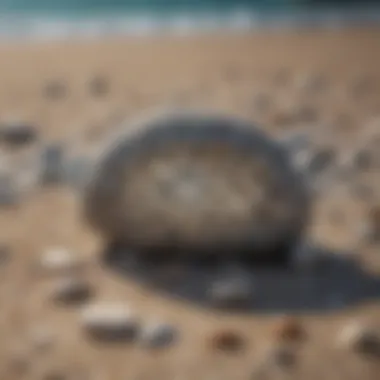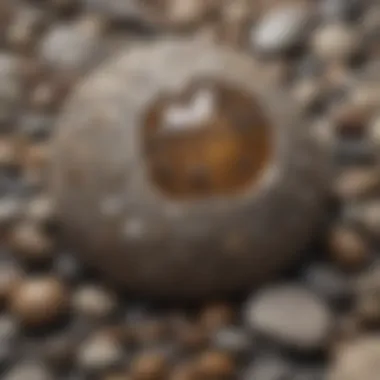Exploring the Fascinating Petoskey Stone


Intro
History and Origins
Overview of Collectibles, Rocks, and Fossils
For rock and fossil collectors, the Petoskey stone stands out as a significant collectible. Its formation dates back approximately 350 million years during the Devonian period. At that time, the area now known as Michigan was underwater, populated by vibrant coral colonies. Over millions of years, geological changes and natural processes transformed these corals into the fossilized stones we see today.
Historical Significance and Cultural Impact
The Petoskey stone holds cultural importance in Michigan. It has become a symbol of local heritage, often linked to the state's identity. Many residents and tourists engage in the activity of stone hunting, searching along Lake Michigan's shores. The stone has also found its way into art, jewelry, and craftwork, becoming a representation of the Great Lakes region. Its popularity is evident in local festivals that celebrate its uniqueness, fostering a deeper appreciation among new and seasoned collectors.
Identification and Classification
Guide to Identifying Rocks and Fossils
Identifying a Petoskey stone requires an understanding of its distinct characteristics. When collecting, look for the following traits to confirm its identity:
- Hexagonal Patterns: Clear hexagonal shapes that resemble honeycombs.
- Coloration: Shades of light gray to tan, often with darker flecks.
- Texture: A smooth and polished surface, indicative of erosion over time.
Common Types and Variations
While the Petoskey stone is primarily recognized for its fossilized coral appearance, variations do exist. Some notable types include:
- Charlevoix Stone: Similar but larger and often less defined patterns.
- Fossilized Coral: General category for other fossil types found in the same region, which may carry different textures.
"Understanding the unique traits of the Petoskey stone can elevate the experience of collection and appreciation for its ecological history."
As collectors gather more knowledge about the Petoskey stone, it enhances their connection to nature and the geological narratives captured in each stone.
Foreword to Petoskey Stones
The Petoskey stone is not merely a geological curiosity; it holds historical and cultural significance, particularly for the state of Michigan. This section serves as a foundation for comprehending what Petoskey stones are, their origins, and their relevance in both natural history and the context of local culture. It instigates a deeper appreciation for these captivating fossils, inviting enthusiasts to explore their unique characteristics and the environments where they are found.
Defining Petoskey Stones
Petoskey stones are fossilized corals belonging to the genus Hexagonaria. These corals thrived in shallow waters during the Devonian period, approximately 350 million years ago. An identifiable feature of the Petoskey stone is its unique hexagonal patterns, which are a product of the coral's structure. The stones exhibit a range of colors, often revealing shades of gray, brown, and taupe. The fossilization process transforms the corals into harder, more durable stone, allowing them to be collected and cherished by enthusiasts.
While these stones are primarily recognized in Michigan, they also contribute to broader discussions in geology and paleontology. Understanding what defines a Petoskey stone allows collectors to appreciate their beauty, rarity, and the geological history they encapsulate.
A Brief History of Petoskey Stones
The history of Petoskey stones is intertwined with the geological timeline of Michigan. Fossil corals from the Devonian period are found across the state's limestone deposit regions. Local Native American tribes, such as the Ottawa and Chippewa, valued these stones. They often incorporated them into cultural artifacts and viewed them as symbols of connection to the land.
In the 19th century, as tourism blossomed in Michigan, Petoskey stones gained popularity among visitors. They were marketed as unique souvenirs, and specific locations became famous for their abundance of these fossils. By the early 20th century, the Petoskey stone was designated as Michigan’s state stone. This designation further solidified its role in local identity and heritage.
Today, understanding the history of Petoskey stones offers perspective on their importance. They are more than objects of collection; they represent a continuum of natural history and human interaction with the environment.
Geological Background
Understanding the geological background of the Petoskey stone is crucial. It provides insight into why this unique fossilized coral captivates collectors and scientists alike. This section addresses formation, discovery, and the environmental elements that affect its presence. By exploring these topics, readers gain a comprehensive understanding of what the Petoskey stone represents in geological terms.
Formation of the Petoskey Stone
The formation of the Petoskey stone is a layered process involving ancient coral reefs and fossilization. It is beneficial to discuss this to grasp the historical context of the stone.


Coral Reefs of the Devonian Period
During the Devonian period, which occurred approximately 350 million years ago, large coral reefs thrived in what is now Michigan. These reefs were expansive ecosystems, teeming with marine life. The coral reefs formed a key characteristic of the region's geology.
Their preservation contributes to the Petoskey stone's unique structure. The ancient corals evolved into the fossilized forms we see today. One notable aspect of these reefs is the intricate patterns that resemble honeycombs, making them visually captivating. This feature enhances their desirability among collectors, adding to their allure.
Fossilization Process
Fossilization is a complex process that turns the coral organisms into stone. This process plays a significant role in producing Petoskey stones. Primarily, the coral undergoes mineralization over time.
The carbonate material replaces the organic coral, preserving its shape and internal structures. This feature allows collectors to observe details that reflect the ancient marine environment. However, fossilization is not uniform; variations can result in different appearances and characteristics within the stones.
Impact of Geological Events
Geological events have shaped the presence and visibility of Petoskey stones today. Factors like erosion, sedimentation, and shifting tectonic plates have impacted how and where these stones are found.
For instance, glacial movements during the Ice Ages exposed many Petoskey stones in northern Michigan, revealing them to collectors. The ongoing geological processes continue to shape their distribution. This adds an element of unpredictability for enthusiasts gathering these natural treasures.
Discovering Petoskey Stones
Not all locations are equal when it comes to discovering Petoskey stones. Identifying the right places increases the likelihood of a successful search. Understanding local geology aids in finding these fossilized wonders.
Locations of Interest
Some locations are particularly renowned for Petoskey stones. The shores of Lake Michigan are among the best spots for finding them. Notable areas include the Petoskey State Park and the beaches near Harbor Springs. These locations have a high concentration of fossilized coral, making them ideal for collectors.
A key characteristic of these areas is the availability of loose stones on the shore, especially after storms. This unique condition helps expose more stones for collection.
Environmental Factors for Findings
Several environmental factors affect how and when Petoskey stones can be found. Weather conditions, such as rain or high winds, can shift stones along the shoreline, uncovering previously hidden specimens.
The time of year also plays a role; spring and early summer often yield better results due to natural erosion processes. This understanding of cycles and conditions enhances the chances for avid collectors eager to add to their collections.
Physical Characteristics
Understanding the physical characteristics of Petoskey stones is essential for collectors and enthusiasts. These traits help in identifying genuine stones and appreciating their intricate beauty. Color variations and patterns play a significant role in attracting collectors and determining the value of these fossils. Recognizing these features is not only rewarding but also enriching for anyone involved.
Identifying Features
Color Variations
Color variations in Petoskey stones are notable and can significantly influence both identification and desirability. The hues can range from grey to light brown, containing specific undertones such as pink or buff. This variety in color is a result of the mineral content and the environmental conditions during formation.
The key characteristic of these color variations is their direct link to the geological history of the area. For collectors, the presence of vibrant coloration can indicate a well-preserved stone. However, it is important to note that more color is not necessarily better. Some collectors prefer more subdued colors for their organic appearance, finding beauty in simplicity.
In addition, these color variations may exhibit inconsistencies. This can sometimes complicate the identification process for less experienced collectors. Awareness of this unique feature allows for a deeper appreciation of the stone's provenance and enhances its significance.
Patterns and Textures
The patterns and textures present in Petoskey stones are profound identifiers. Each stone features a unique design, commonly displaying intricate coral formations. These patterns tell a story of the coral’s growth over millions of years, making each piece a true snapshot of geological history.
The key characteristic of these patterns is their mesmerizing visual appeal. They attract not only fossil collectors but also artists and designers who value the stones for their aesthetic properties. Unique textures can indicate the fossil’s exposure to various environmental factors, which adds to its charm.
However, variability in patterns can sometimes pose challenges. Collectors may find that similar designs appear in different stones from the same area, making precise identification difficult without additional context. Still, the beauty of diverse patterns contributes to the stone's allure and reinforces its value among collectors.


Comparative Analysis
Similar Fossils
When examining Petoskey stones, it is beneficial to compare them with similar fossils. One notable example is the St. Clair Coral, which shares some similarities in appearance and composition. Understanding these connections helps collectors recognize the distinct characteristics of Petoskey stones
The key characteristic of similar fossils is their value in enhancing knowledge of the Petoskey stone. By learning about their counterparts, collectors can appreciate the unique nature of Petoskey stones in contrast. However, confusion can arise when exploring these similarities, necessitating careful examination of each specimen.
Distinct Traits of Petoskey Stones
Petoskey stones possess distinct traits that set them apart from other fossils. Features such as their hexagonal patterns and the specific coral species they originate from offer a deep understanding of their uniqueness. This distinctiveness is critical for collectors aiming to build a meaningful collection.
The key characteristic of Petoskey stones is their educational value. Each trait not only serves as a visual appeal but also reflects the geological processes involved in their formation. This educational aspect is crucial for informed collecting and appreciation. Yet, it is essential to acknowledge that novice collectors may initially overlook these details, potentially leading to misidentification.
"Recognizing and understanding the physical characteristics of Petoskey stones is vital for an informed collection."
In summary, the physical characteristics of Petoskey stones encompass color variations, patterns, and their comparative analysis with similar fossils. This understanding enriches the knowledge base of collectors and fosters a greater appreciation for these geological treasures.
Cultural Significance
The Petoskey stone holds a unique place not only in the geological history of Michigan but also in the cultural and social fabric of the area. Its presence has influenced local traditions, art, and even tourism. Understanding this significance offers insights into how a natural object can weave itself into the identity of a region.
Petoskey Stone in Local Lore
Local folklore surrounding the Petoskey stone is rich and compelling. Many stories highlight the stone's origins, often connecting it to Native American legends. Various tribes in Michigan have their interpretations of what the stones symbolize. These tales not only enrich the local culture but also serve to educate future generations about the geological wonders of their homeland.
Petoskey stones are viewed as good luck charms. Many people believe carrying a Petoskey stone can lead to positive outcomes in life and love. The stones are frequently presented as gifts, particularly during significant life events like weddings or births. This belief connects the stones to a deeper emotional value, establishing them as not just geological specimens but symbols of hope and well-wishing.
Symbolic Value in Michigan
In Michigan, the Petoskey stone has evolved into a state symbol. In 1965, it was designated as the state stone, solidifying its importance within the state’s geological and cultural narrative. As a result, it is often depicted in state promotional materials, art, and memorabilia.
The use of Petoskey stones in art and jewelry showcases their aesthetic appeal. Local artisans frequently incorporate these stones into their works, reflecting both craftsmanship and a connection to the land. This artistic representation has further popularized the stone among residents and tourists alike, contributing to local economies through the sale of handmade goods.
Municipal events often celebrate the Petoskey stone. Festivals and fairs centered around the stone attract enthusiasts and collectors from various areas. These gatherings serve as venues for education, sharing stories, and fostering community engagement, transforming the stones into a focal point of social interaction.
The Petoskey stone thus embodies a blend of natural beauty and cultural richness. Its significance extends beyond mere geological interest, encapsulating the heart of Michigander identity. People engaging with these stones participate in a tradition that connects them to the land and its history, creating a lasting bond that resonates through generations.
Collecting Petoskey Stones
Collecting Petoskey stones is both a rewarding hobby and a way to connect with Michigan's unique geological heritage. Collectors appreciate these fossils not only for their beauty but also for their geological history. Engaging in this activity can enhance knowledge about Earth's past life forms, specifically the coral reefs that once thrived during the Devonian period. Moreover, the act of collecting can promote environmental awareness and conservation efforts. Individuals who venture into the outdoors to seek these stones often find a deep sense of purpose, connecting with nature.
Tips for Aspiring Collectors
Best Practices for Collecting
When collecting Petoskey stones, certain best practices can enhance the experience and increase the likelihood of success. One of the key characteristics of effective collecting is choosing the right location. The shores of Lake Michigan, especially around Petoskey, are prime spots for finding these fossils. The best practice involves researching favorable sites prior to a collecting trip, ensuring less time wasted and more stones found.
Another important aspect is knowing the right time of year to collect. Late spring to early fall offers the best conditions, as the ebb and flow of the water can unveil hidden stones. Additionally, while it is tempting to grab every stone that catches your eye, aspiring collectors should focus on quality over quantity. Identifying unique patterns or distinctive coloring can make for a more satisfying collection.
However, it’s crucial to approach collecting with respect for natural habitats. Avoid disturbing wildlife and be mindful of local regulations regarding fossil collection. Following these best practices not only helps in building a respectable collection but also contributes positively to local ecosystems.
Ethical Considerations
Ethical collecting is an essential component of any responsible hobby. Understanding the implications of removing Petoskey stones from their natural settings is vital for both collectors and the environment. The key characteristic of ethical collecting lies in respecting local laws and regulations. Many areas have specific rules regarding the collection of natural resources, including fossils. Being aware of these guidelines is a responsible practice that protects both the collector and the local ecosystem.


In addition, collectors should strive to practice sustainable collecting methods. Only take stones that are abundantly available, and always leave some behind for others to enjoy. This unique feature of ethical collecting fosters a sense of community among enthusiasts and ensures that future generations can also experience the joy of seeking these fossils.
Balancing the desire to collect with the need to preserve is what makes ethical considerations significant in this hobby. By fostering an understanding of the ecological impact, collectors promote a future where stones, like the Petoskey, can continue to tell their stories.
Tools and Techniques
Essential Tools for Collectors
Having the right tools can enhance the collecting experience significantly. Essential tools may include a sturdy bag to carry collected stones, a magnifying glass for closer inspection, and a notebook for documenting finds. The key characteristic of these tools lies in how they allow collectors to appreciate the beauty and details of each stone in greater depth.
One unique feature of using a magnifying glass is that it helps to identify the intricate patterns and textures unique to each Petoskey stone. This feature provides an advantage, as it enables collectors to distinguish between regular stones and Petoskey stones with greater precision. Furthermore, a notebook encourages the practice of recording locations and specific characteristics of finds, enriching the overall collecting narrative.
Effective Identification Methods
Recognizing a genuine Petoskey stone can prove challenging for new collectors. Effective identification methods involve understanding the stone's unique features. Typical characteristics include a light gray or brown color, along with distinctive patterns reminiscent of coral. A helpful tip for identification is to look for a hexagonal pattern across the surface of the stone.
The key characteristic of effective identification methods is the ability to differentiate between similar-looking stones. By familiarizing oneself with the various types of fossils mimicking Petoskey stones, collectors can avoid mistakes. This knowledge proves beneficial in maximizing finds.
A unique feature of effective identification is using a small cloth to clean the stone while out in the field. This allows for immediate evaluation of texture and pattern, aiding in making more informed decisions about whether to keep a particular find. However, this effort requires care, as some stones are fragile and might lose their features with excessive handling.
In closing, understanding how to identify Petoskey stones effectively contributes significantly to the collecting experience, generating excitement and satisfaction within this fascinating hobby.
Preserving Petoskey Stones
Preserving Petoskey stones is crucial for enthusiasts who value their unique beauty and geological significance. Collectors often seek to maintain the integrity of these fossils. Proper preservation methods can enhance their aesthetic appeal and help them retain their historical context. Neglecting preservation can lead to deterioration. Factors like environmental exposure, handling practices, and cleaning methodologies directly impact the longevity of these stones.
Storage Recommendations
Proper Handling
Proper handling of Petoskey stones is fundamental. When collectors wish to assess their stones, gentle handling is key. Dropping or mishandling can cause chips or breaks, which might diminish the stone's value. Using two hands to hold the stone can prevent accidents. It’s also beneficial to minimize prolonged exposure to moisture. This practice helps in preserving the fossilized nature of the coral structure.
A key characteristic of proper handling is awareness. Collectors should be mindful of surroundings and avoid hard surfaces during examination. Understanding the stone's fragility enhances a collector's experience as they strive to appreciate its unique features.
Optimal Environmental Conditions
Optimal environmental conditions significantly contribute to preserving the beauty of Petoskey stones. Storing them in a stable environment is critical. Excessive humidity or extreme temperature fluctuations can lead to degradation. Ideally, these stones should be kept in a cool, dry place. A climate-controlled area can prevent mold growth, which is detrimental.
The unique advantage here is that maintaining consistent conditions not only protects the stone physically but also preserves its visual appeal. Using a silica gel packet can help absorb moisture in storage areas, further enhancing conditions.
Cleaning and Maintenance
Safe Cleaning Practices
Safe cleaning practices are essential for maintaining the integrity of Petoskey stones. Many collectors may be tempted to use harsh chemicals to enhance appearance; however, this can lead to irreversible damage. Using warm water and a soft brush is a preferred method. This approach helps to remove dust while preserving the stone's natural luster.
A significant characteristic of safe cleaning is that it emphasizes gentleness. Collectors who are mindful of their cleaning approach tend to enjoy longer-lasting and visually appealing stones. Regular but gentle cleaning can help prevent buildup of dirt, which may obscure the stone's distinctive patterns.
Restoration Techniques
Restoration techniques can be critical for preserving damaged Petoskey stones. In factors such as cracks or chips, using a clear resin may resolve minor issues. This method can make a noticeable improvement, often restoring the stone's appearance. However, one should note that significant repairs can sometimes subtract from its authenticity.
The advantage of restoration is its capacity to revive a stone to its former glory while maintaining usability. Yet, collectors should remain cautious and consider restoration's implications on value. Understanding the balance between preservation and alteration is essential for any serious collector.
Finale
The conclusion serves as a critical component of this article. It encapsulates the essence of what has been presented, drawing connections between the various aspects of the Petoskey stone. While discussing the geological formation, physical attributes, and cultural significance, it also highlights the enduring appeal of this unique fossil.
Reflecting on the Petoskey stone allows for a deeper appreciation of its multifaceted nature. This appreciation is not just for rock and fossil collectors but also for anyone interested in natural history. Understanding its formation from ancient coral reefs to its current status as a state symbol fosters a connection to Michigan's geological heritage.
Moreover, the conclusion reflects on practical elements, such as conservation and ethical collecting practices, which are vital for the sustainable enjoyment of this natural wonder. By synthesizing the information presented, the article emphasizes the importance of preserving the Petoskey stone for future generations. It urges collectors to honor their responsibilities toward the environment while indulging in their passion.
In summary, the conclusion reiterates that the Petoskey stone is more than just a collectable; it is a piece of history, culture, and nature that deserves respect and protection.



